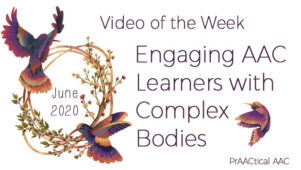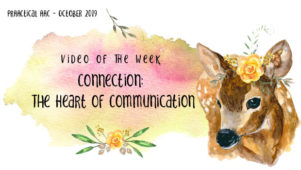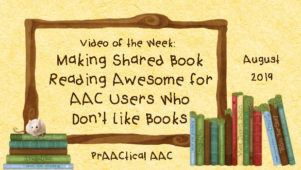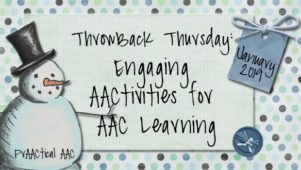Strategy of the Month: How Clear Priorities and A Little Sacrifice Build Engagement
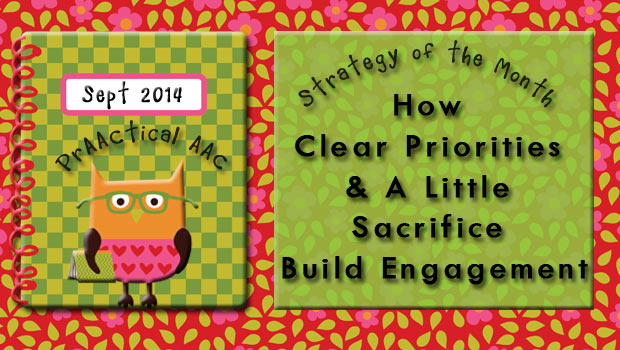
We can’t complete our thoughts on engaging AAC learners without a bit of conversation around the topic of priorities.
Here’s the main idea: Go into each activity having a clear priority for what you want to achieve. Everything else become negotiable.
As SLPs, sometimes we want it all. We want therapy activities where the AAC learner initiates communications, uses new vocabulary, creates novel sentences, experiments with new grammatical forms, and kicks some morphological butt. We.want.it.all.
After a few decades of being an AAC practitioner, I think I’m finally learning that trying to have it all isn’t always the best option. It isn’t about what I want, it’s about what my client needs. Sigh.
In this approach, we look at the lesson or activity and create our “Must Have List.’ For Mayra, a kindergartner just learning to use symbols for the first time, our lessons ‘must’ be engaging, have high pay-off relative to the effort, and give her opportunities to use an affirmation (YES) signal. Everything else is on the ‘Wish List.’ Would I like her to be able to make eye contact? You bet! Is it a good idea for her to discriminate between symbols? Of course. Should she be able to follow my directions? Yes. But I’m ignoring that for now. To include those other skills while I am teaching her this new skill of saying YES, would be overwhelming and too challenging for this student. By trying to do too much, I risk losing her interest and motivation to engage with me. Establishing a single top priority allows us to focus on that one skill and reminds us not to over-tax the student. Here’s an example.
Mayra is learning to move her hand toward the YES symbol on her laptray so that she can use it to answer yes/no questions for now. Once she has the hang of it, we’ll use it for partner assisted scanning and, possibly a PODD book. For now, though, we want to provide lots of opportunities for saying YES so we can teach and reinforce that skill. She has fairly good arm movement so the physical ability to move toward the YES symbol is not very hard for her. What she doesn’t yet understand is the concept. The idea that putting her hand on a YES symbol means affirmation.
- “Do you want this one?” “Yes.” (That’s it! I want the Tinker Bell pointer.)
- “Do you like when he does that?” “Yes.” (I like when Diego sings to me.)
- “Do you want a turn?” “Yes.” (I want a turn saying the letter of the week.)
- “Do you think she’s a little crazy?” “Yes.” (I agree. Ms. Elinora is crazy!)
- “Do you think we should write a note home about it?” “Yes.” (I think it is a good idea to write a note to mom about my awesome day.)
She is learning the concept, the word for that concept, and the symbol for it. That’s a lot!
So, if we want her to focus on learning to say YES, we promote success by:
- Keeping the motoric aspect of the response easy
- Modeling it (Speak AAC)
- Asking easy YES questions, not hard ones for now
- Providing lots of opportunities
- Accepting approximations (e.g., looking at the symbol and moving toward it)
- Providing support via least-to-most prompting
- Broadcasting her efforts and success {e.g. “Ms. Elinora, I think Mayra just said ‘YES.’ I think she wants a turn with Moe.”)
- Giving feedback that helps her know what she did right (e.g., “Oh! I saw you touch the YES symbol. I saw you say ‘YES’ because you want a turn!”)
- Mayra engages in the activity and looks forward to trying out this new skill, because we haven’t made it overwhelming. She sees that it’s something she can do, and that’s inspiring. Making one thing easy (motor component) lets us maximize attention and learning in other areas (cognitive and linguistic components).
Michael is a student who is learning academic vocabulary. He, too, benefits when we set a single priority. He needs to get better at the motor act of making selections on his SGD efficiently and without errors. But when he’s involved in a vocabulary activity learning words like ‘promise’ and ‘effort,’ we ignore that and keep the motor demands simple. Why? Because the access issue is not our top priority in this lesson. In the activity, he may simply use a rating scale (not on his SGD) to tell us whether the sentences we read to him use the word correctly, somewhat correctly, or incorrectly. The simple 3-choice format makes the motor response easy and allows him to focus on what we are teaching – new word meanings. Michael engages readily and attends for a longer period of time because it doesn’t make excessive demands on him. Making one thing easy (motor component) lets us maximize attention and learning in another area (linguistic component).
Setting a top priority takes discipline. The idea of NOT working on access or navigation, for example, while building semantic knowledge can seem unsettling. We want to work on everything all the time. That works for some learners, but not so much for others. If you’re working with learners who struggle, consider reducing the task demands to focus on one thing at a time. Try going into the activity with a clear idea of the top priority for the lesson and implementing it in a way so that everything else takes a backseat to the target skill. You might just get some prAACtical results.
Filed under: Strategy of the Month
Tagged With: engagement, priorities
This post was written by Carole Zangari

